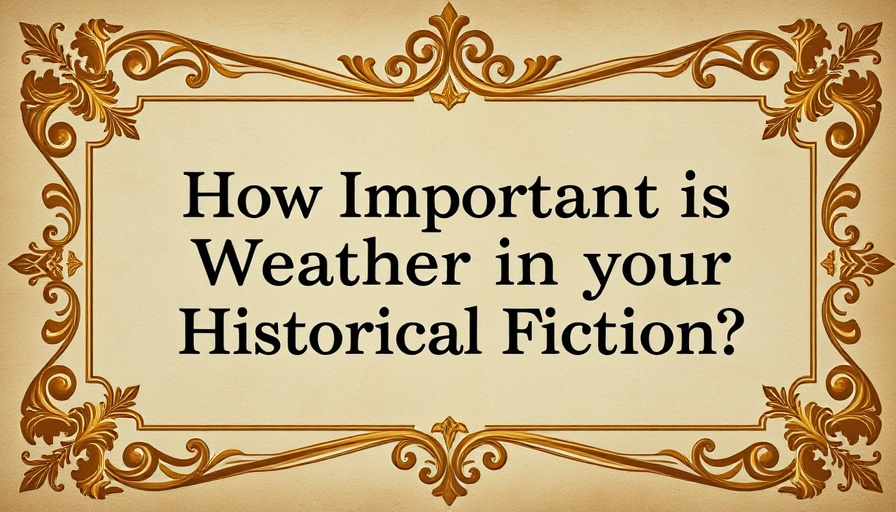
Weather: The Unseen Character in Historical Fiction
In historical fiction, weather serves not only as a backdrop but also as a pivotal character that shapes narratives and influences character development. As authors like Linda Ulleseit and C. V. Lee affirm, the environment—from snowstorms to torrential rains—has the power to affect the mood, pace, and progression of a story. For those immersed in writing historical narratives, understanding and integrating weather can transform a good story into a compelling journey.
Why Weather Matters: Setting the Scene
Weather is more than mere description; it's a forcible element of setting that can evoke strong emotions and memories in readers. Consider how Ulleseit utilized weather records from Fort Snelling, Minnesota, to ground her narrative in authenticity. By referencing specific weather patterns from 1820, she didn’t just paint a vivid picture; she allowed her readers to experience the hardships and adventures faced by her characters. Such meticulous research creates a layered narrative that breathes life into historical details, making the past accessible and engaging.
Weather as a Plot Device: Creating Tension and Suspense
Engaging readers involves evoking sensory experiences that make historical periods tangible. C. V. Lee exemplifies this in her Dahlquin Series set in thirteenth-century Ireland, where the omnipresent rain is woven through the fabric of daily life, affecting characters’ clothing, travel, and emotions. Lee effectively uses heavy rain as a plot device in her book Archer’s Grace, where rising water levels flood a river and trap characters, heightening tension and urgency. Such depictions not only integrate weather into the fabric of the story but enhance the reader's emotional investment.
Extreme Environments Elevate the Stakes
Stories unfolding in extreme weather conditions—like those set in arid deserts or icy tundras—bring urgency to both plot and character decisions. In these settings, weather can become a formidable antagonist, affecting survival and choices significantly. Understanding how weather impacts life in various contexts allows writers to depict genuine challenges that resonate with readers. For instance, characters coping with seasonal extremes present fertile ground for exploring themes of resilience, survival, and adaptation.
Connecting Readers with the Past: Evocative Weather Descriptions
Using weather to contextualize emotions enhances reader engagement. Detailed descriptions of storms can mirror internal conflicts, while bright sunny days can imply hope or celebration. This layered approach not only enriches the narrative but offers an emotional anchor that mirrors the turbulence of historical events. Writers should strive to create sensory experiences that evoke nostalgia subtly, thereby allowing readers to feel history rather than just observe it.
Researching Weather Accurately: Resources and Techniques
For authors dedicated to authenticity, extensive research is paramount. Resources like historical weather databases can be invaluable, allowing writers to track patterns and events that affected life during their chosen time periods. Online archives and local historical societies can offer insights into specific climate conditions, helping to craft rich, nuanced narratives. Additionally, incorporating weather-related anecdotes can strengthen authenticity, offering readers relatable experiences amidst historical settings.
A Call to Embrace Weather in Storytelling
Understanding the significance of weather in historical fiction not only enhances storytelling but invites readers into richer, more immersive worlds. As you craft your narratives, consider how weather has shaped events and emotions throughout history. Engage with your readers by letting them feel the winds of change blowing through your characters' lives.
So the next time you sit down to write, remember: the weather is not just a side note; it's an integral part of your story's heartbeat.
 Add Row
Add Row  Add
Add 




Write A Comment